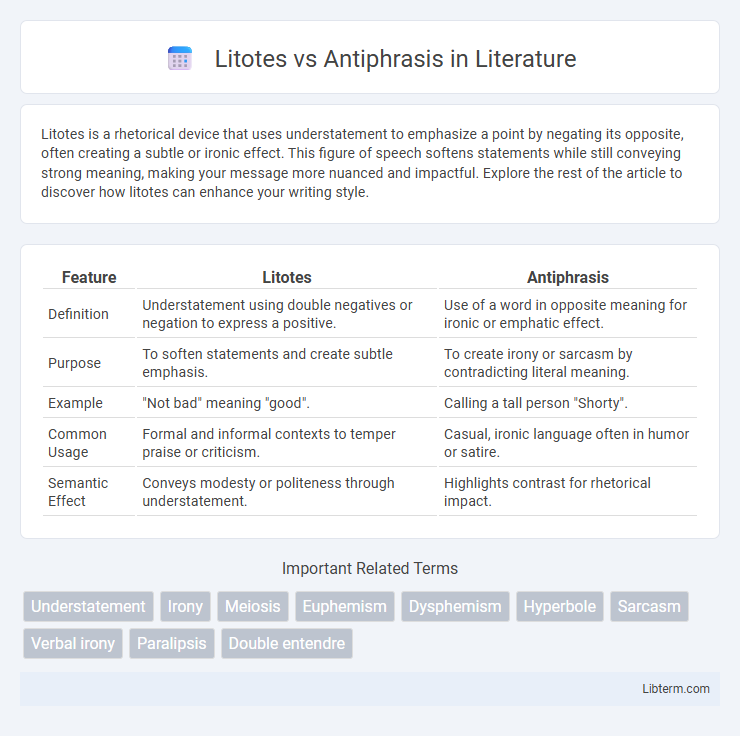Litotes is a rhetorical device that uses understatement to emphasize a point by negating its opposite, often creating a subtle or ironic effect. This figure of speech softens statements while still conveying strong meaning, making your message more nuanced and impactful. Explore the rest of the article to discover how litotes can enhance your writing style.
Table of Comparison
| Feature | Litotes | Antiphrasis |
|---|---|---|
| Definition | Understatement using double negatives or negation to express a positive. | Use of a word in opposite meaning for ironic or emphatic effect. |
| Purpose | To soften statements and create subtle emphasis. | To create irony or sarcasm by contradicting literal meaning. |
| Example | "Not bad" meaning "good". | Calling a tall person "Shorty". |
| Common Usage | Formal and informal contexts to temper praise or criticism. | Casual, ironic language often in humor or satire. |
| Semantic Effect | Conveys modesty or politeness through understatement. | Highlights contrast for rhetorical impact. |
Understanding Litotes: Definition and Origins
Litotes is a rhetorical device that employs understated language by using double negatives or negations to express a positive statement, originating from ancient Greek rhetoric. This figure of speech softens an assertion, often conveying modesty or irony, and is widely found in classical texts as well as modern communication. Understanding litotes involves recognizing its linguistic structure and historical context to appreciate its subtle emphasis.
Exploring Antiphrasis: Meaning and History
Antiphrasis is a rhetorical device where a word or phrase is used in a sense opposite to its literal meaning, often for ironic or humorous effect. This figure of speech dates back to ancient Greek literature, prominently featured in works by classical authors such as Aristophanes and later employed by Latin writers like Cicero. Its historical usage highlights antiphrasis as a subtle tool for sarcasm and emphasis, enriching language by conveying complex attitudes through contradiction.
Litotes vs Antiphrasis: Key Differences
Litotes employs deliberate understatement by using double negatives or negating the opposite to express an affirmative, such as saying "not bad" to mean "good." Antiphrasis involves using a word or phrase in a sense opposite to its literal meaning, often sarcastically, like calling a tall person "Shorty." The key difference lies in litotes' subtle affirmation through negation versus antiphrasis' ironic or sarcastic reversal of meaning.
Linguistic Functions of Litotes
Litotes serves as a linguistic tool that employs understatement by negating the opposite to convey emphasis or irony, subtly softening statements while enhancing politeness and indirectness in communication. Unlike antiphrasis, which uses words in a sense opposite to their literal meaning for ironic or humorous effect, litotes functions to create nuance and restraint, often reinforcing the speaker's attitude or emotional stance. This technique plays a crucial role in rhetoric and discourse by enabling speakers to express modesty, mitigate bluntness, or intensify meaning through deliberate understatement.
The Role of Antiphrasis in Rhetoric
Antiphrasis functions as a powerful rhetorical device by conveying meaning through deliberate understatement or opposite expression, enhancing irony and emphasizing contrast in speech. It often challenges the audience's expectations, fostering deeper engagement and provoking critical thought about the speaker's true intent. This technique relies on context and tone, making it essential for effective persuasion and nuanced communication in literature and everyday discourse.
Common Examples of Litotes in Literature
Litotes is a form of understatement that uses negation to express a positive sentiment, often found in classic literature such as Shakespeare's "Macbeth," where the phrase "not too bad" implies something good. Antiphrasis, on the other hand, involves using a word or phrase in a sense opposite to its usual meaning, often seen in sarcasm or irony. Common examples of litotes in literature include Jane Austen's use of "not a bad idea" in "Pride and Prejudice" and J.D. Salinger's "not very pretty" in "The Catcher in the Rye," highlighting subtle emphasis through restrained language.
Antiphrasis in Everyday Language
Antiphrasis is a rhetorical device where words are used in a sense opposite to their literal meaning, often for ironic or humorous effect, commonly seen in everyday phrases like calling a tall person "Shorty" or a slow-moving friend "Speedy." This figure of speech relies on context and tone to convey its intended meaning, enhancing communication by adding subtlety or wit. Unlike litotes, which employs understatement through negation, antiphrasis directly contrasts word meaning to enrich language in casual conversations and social interactions.
Effects of Litotes and Antiphrasis on Tone
Litotes employs deliberate understatement to create a subtle, often ironic tone that softens criticism or praise, enhancing a speaker's modesty or sarcasm. Antiphrasis uses words in a meaning opposite to their usual sense, producing a sharp, ironic tone that can emphasize humor, sarcasm, or rhetorical contrast. Both devices manipulate tone by altering expected meanings, influencing reader or listener perception through irony and emphasis.
When to Use: Practical Guidelines
Use litotes to create understatement that softens statements and adds subtle emphasis, especially in formal or polite communication. Apply antiphrasis to convey irony or sarcasm by expressing the opposite of the intended meaning, often in informal contexts or humor. Choose litotes when desiring a nuanced, modest tone and antiphrasis for impactful, ironic effect that challenges literal interpretation.
Comparing Litotes and Antiphrasis in Modern Writing
Litotes and antiphrasis both employ understatement but serve different rhetorical purposes in modern writing: litotes uses deliberate negation to express modesty or emphasize a point subtly, as in saying "not bad" to mean "good," while antiphrasis involves using words ironically opposite to their literal meaning, often for humor or sarcasm, like calling a tall person "Shorty." Litotes tends to soften statements, making them more polite or nuanced, whereas antiphrasis sharpens tone by engaging readers with irony or wit. Understanding these devices enhances the effectiveness of dialogue, characterization, and persuasive language in contemporary literature and media.
Litotes Infographic

 libterm.com
libterm.com